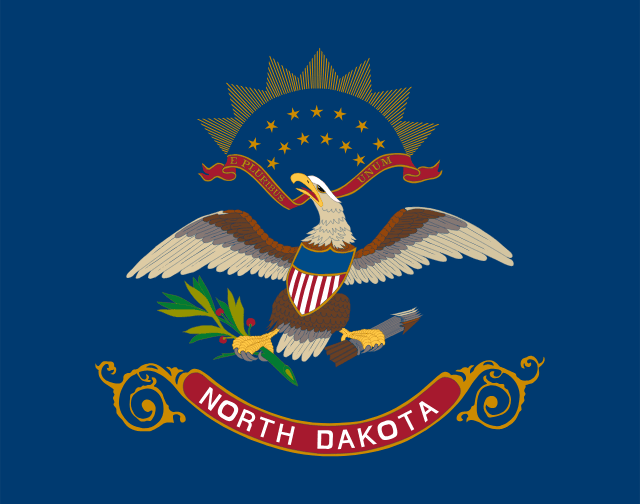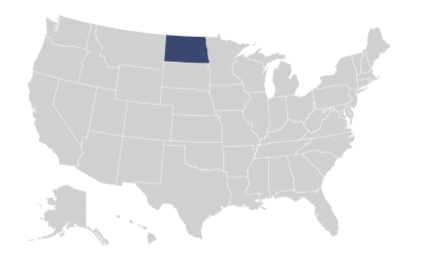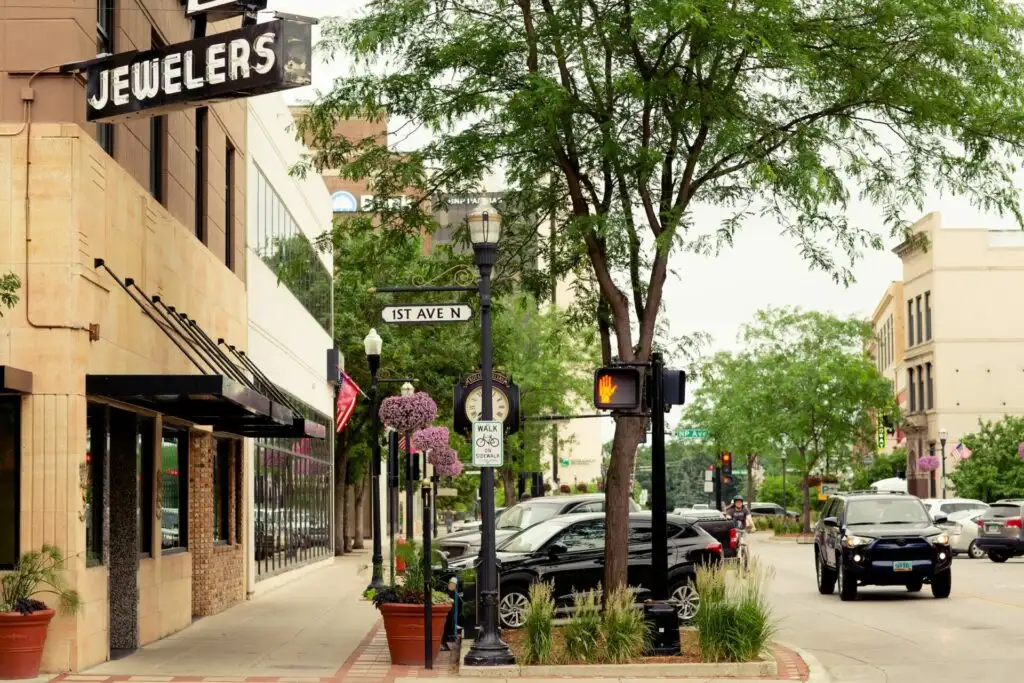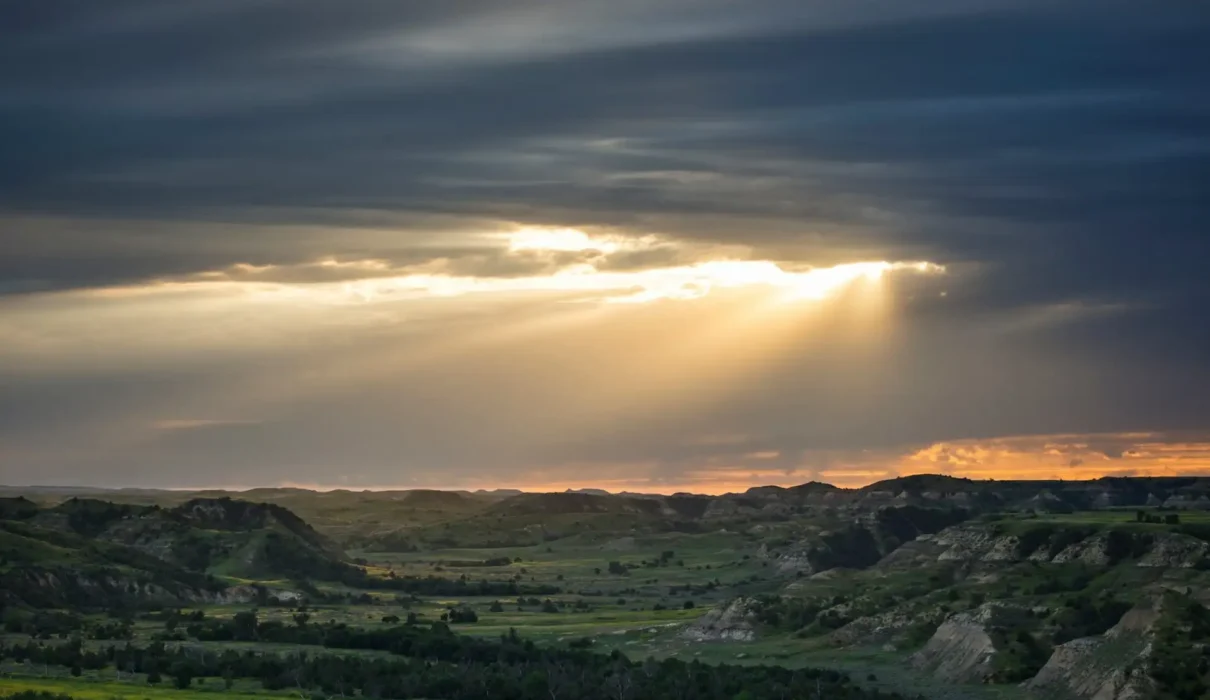Welcome to North Dakota, the unknown jewel in the heart of the USA, which is an unforgettable travel destination with its stunning natural beauty, rich history and vibrant culture. As the “Peace Garden State”, named after the international peace garden on the border with Canada, North Dakota offers a unique mix of experiences to discover. In this comprehensive travel guide, we take you on a journey of discovery through North Dakota. Ready for the adventure? Then let’s explore the beauty and diversity of this state together.
natural beauty and outdoor adventures
North Dakota is characterized by its endless plains, sprawling farms and wide skies that frame the stunning landscape in all its glory. Theodore Roosevelt National Park , named after the 26th President of the United States who discovered his love of nature here, offers breathtaking views, scenic hiking trails and the chance to see wildlife such as bison, wild horses and elk in their natural habitat. The scenic Badlands provide a dramatic backdrop for outdoor activities such as hiking, camping and photography.
insight into history
North Dakota has a fascinating history that spans from Native Americans to early European settlers to modern energy production. Visit the North Dakota Heritage Center & State Museum in Bismarck for a comprehensive look at the state’s historical and cultural development. Discover the rich culture of indigenous peoples at historic sites like Knife River Indian Villages National Historic Site.
Modern Culture and Economy
Despite its deep historical roots, North Dakota is also a place of modern culture and economy. Agriculture remains an important industry, with wheat, cattle and sunflowers among the main products. In recent years, energy production, particularly through fracking, has gained importance, opening up new economic prospects for the state. Cities such as Fargo and Bismarck are vibrant centers of culture, with a variety of museums, galleries, theaters and culinary delights.
Why visit North Dakota?
North Dakota is a place that delights visitors with its tranquility, beauty and hospitality. It is a perfect destination for those who want to escape the hustle and bustle of big cities and enjoy unspoiled nature. The combination of natural beauty, historical depth and modern vitality makes North Dakota a place that touches both the heart and the spirit.
planning your trip
When planning your trip to North Dakota, consider seasonal weather conditions to make the most of the outdoor activities and attractions. Whether you’re interested in history, love the outdoors, or are looking for cultural experiences, North Dakota offers a variety of accommodation options, from cozy bed and breakfasts to modern hotels, that will make your stay unforgettable.
Flag

The flag of North Dakota, adopted in 1911, honors the state’s military heritage and commitment to the United States. It is based on the emblem of the North Dakota Regiment, which served in the Spanish-American War and in the Philippines.
The flag features an eagle emblem on a dark blue background. The eagle, a symbol of the United States, holds in its beak a ribbon with the national motto “E Pluribus Unum” – “Out of many, one”. In its talons, the eagle holds a bundle of thirteen arrows and an olive branch, symbols of the original 13 states and the desire for peace.
The eagle features a shield with thirteen red and white stripes, above which is a blue area with thirteen stars representing the new states added to the Union. Above the eagle is the sunray motto “The Great Seal of the State of North Dakota” on a yellow band.
| Capital city | Bismarck |
|---|---|
| Area | 183,000 km² |
| In the USA since | November 2, 1889 |
| Resident | 0.8 million |
| time zone | Central: UTC−6/−5Mountain: UTC−7/−6 |
| Left: | nd.gov |

highlights
Unforgettable Experiences in North Dakota: Your Must-See List for the Peace Garden State
A visit to Theodore Roosevelt National Park is a must. Here you can experience the breathtaking landscape of North Dakota in all its beauty. Also a must is a visit to the lively city of Fargo and the historic Fort Mandan.
Theodore Roosevelt National Park
Theodore Roosevelt National Park is an unforgettable sight with its colorful canyons, vast prairies and abundant wildlife. The three different parts of the park offer something for everyone and should not be missed when visiting North Dakota.05

The city of Fargo
Fargo is a cultural center and the artistic heart of North Dakota. With its vibrant arts and culture scene, many museums, galleries and theaters, as well as a fantastic culinary offering, Fargo is a must for every visitor.
Scandinavian Heritage Park
The Scandinavian Heritage Park in Minot is a wonderful place to learn about North Dakota’s Scandinavian heritage. Here you will find traditional Scandinavian buildings and a wealth of information about the cultures that have shaped this state.
Fort Mandan
Fort Mandan is an important place in the history of the USA. It was the winter base of the Lewis and Clark Expedition from 1804 to 1805. Here you can learn more about this important expedition and experience a piece of history first hand.
International Peace Garden
The International Peace Garden, located on the border with Canada, is a symbol of friendship between the two countries and is home to thousands of flower species, scenic walking trails and works of art.
Maah Daah Hey Trail
The Maah Daah Hey Trail is an absolute highlight for outdoor lovers. The more than 150-kilometer-long hiking and mountain bike trail leads through some of the most beautiful landscapes in North Dakota and offers incomparable nature experiences.
Knife River Indian Villages National Historic Site
This historic site preserves the remains of Hidatsa Indian trading villages on the Knife River and offers insight into Native American life before the arrival of Europeans.
Maah Daah Hey Trail
The Maah Daah Hey Trail is a 144-mile hiking and mountain biking trail that winds through scenic badlands and offers breathtaking views and wilderness adventure.
In terms of what you might miss, the Geographical Center of North America in Rugby, although often visited by tourists, is more of a quirky attraction than a must-see. It’s a fun photo stop, but there’s not much else to see or do.
National Parks, State Parks,
Natural Wonders of North Dakota: Untouched Landscapes and Magnificent Parks
A state often overlooked in the vast plains of the American North, North Dakota holds a surprising variety of natural beauty and historical treasures. From the rolling hills of the Great Plains to the deep river valleys, North Dakota offers a unique landscape that ranges from prairie to badlands. North Dakota’s national parks, state parks and national monuments are not only witnesses to the state’s geological and historical history, but also places of tranquility and natural wonder that invite visitors to explore the unspoiled beauty of the American North.
The Prairies and the Heritage of the Great Plains
In the heart of North Dakota lies Theodore Roosevelt National Park , named after the 26th President of the United States, who discovered his love of nature in the North Dakota Badlands. Divided into three geographically separate areas, the park offers a stunning landscape of colorful rock formations, expansive prairies, and abundant wildlife, including bison, wild horses, and prairie dogs. This park is a living monument to America’s natural heritage and wilderness preservation.
The Waterland: Rivers and Lakes
North Dakota may be known for its expansive plains, but the state is also rich in aquatic landscapes. The Missouri River , which winds through the state, provides vital wetlands and the opportunity for numerous water activities. Lake Sakakawea , one of the largest man-made lakes in the United States, created by damming the Missouri River, offers excellent opportunities for fishing, boating, and exploring the scenic shores.
The Badlands: A Window into the Past
The North Dakota Badlands offer a dramatic and rugged landscape that provides insight into millions of years of Earth’s history. The Painted Canyon , part of Theodore Roosevelt National Park, is known for its stunning color and geological formations. This region is not only a paradise for geologists and paleontologists, but also for hikers and photographers who want to capture the unparalleled beauty of this landscape.
Historical Sites and Aboriginal Culture
North Dakota is also a land rich in history and culture. The Knife River Indian Villages National Historic Site preserves the remains of Hidatsa trading villages that played an important role in the fur trade and the history of the Lewis and Clark Expedition. These historic sites offer visitors the opportunity to learn more about Native American cultures and their connection to the landscape.
cities
Urban Treasures of North Dakota: Between History and Modernity
North Dakota, a state characterized by vast prairies, tranquil lakes and the deep history of the Great Plains, may at first glance appear to be a landscape of silence and simplicity. But its cities reveal a rich cultural life that invites visitors to discover the diversity and warmth of the American North.
Fargo , the state’s largest city, is the cultural heart of North Dakota. Fargo surprises with a vibrant arts and theater scene, a growing number of craft breweries and a pride in local history that is expressed at the Plains Art Museum and the annual Fargo Film Festival. Often considered the gateway to the West, the city combines modern city life with the hospitality and openness that characterize North Dakota.
Bismarck , the capital, stands alongside the tranquil flow of the Missouri River and offers a glimpse into state history at the North Dakota Heritage Center & State Museum. The city is also a jumping-off point for exploring the surrounding nature, including the scenic Missouri River, which is ideal for boating and fishing.
Smaller yet full of charm , Grand Forks is known for its university, the University of North Dakota, and a vibrant community that rallies around education and hockey – a true passion in North Dakota. Grand Forks celebrates the arts as much as it does sports, with events ranging from outdoor concerts to art exhibits.
Known as the “Magic City,” Minot earned its nickname from its rapid growth in the early 20th century. Today, the city attracts visitors with the Scandinavian-influenced Norsk Høstfest, North America’s largest Scandinavian festival, and the Roosevelt Park Zoo. Minot is an example of how North Dakota maintains and celebrates its multicultural roots.
Places Worth Seeing
The Hidden Gems of North Dakota: Extraordinary Places Off the Beaten Track
Theodore Roosevelt National Park , known for its scenic badlands and diverse wildlife, includes areas that have already been discussed, but surrounding small towns like Medora offer historical insights and charming experiences closely tied to the park’s heritage. Medora, with its Old West flair, is home to the annual Medora Musical, which takes place in an outdoor stage overlooking the scenic landscape.
Scandinavian Heritage Park in Minot celebrates the cultural roots of Scandinavian immigrants in North Dakota. The park is home to authentic Scandinavian structures, including a stave church, and offers a fascinating insight into the traditions and heritage of the Nordic countries.
Fort Abraham Lincoln State Park , located south of Bismarck , is a historic site that offers insight into the region’s military and indigenous heritage. Visitors can explore the reconstructed Custer House and a Mandan Indian village to gain a deeper understanding of North Dakota’s history.
The Enchanted Highway , a route stretching south from Gladstone to Regent , is known for its giant metal sculptures placed along the road. These works of art, depicting scenes from rural life and local folklore, make the drive a unique visual experience.
The International Peace Garden , located on the Canadian border, is a symbol of friendship between the two nations. The park is home to thousands of flower species, scenic walking trails and artwork expressing the desire for global peace.
In Fargo , North Dakota’s largest city, the Fargo Air Museum features an impressive collection of aircraft and aviation artifacts documenting the region’s aviation history. Fargo’s vibrant downtown also offers a number of galleries, theaters and restaurants that enrich the city’s cultural scene.
Journey through time through North Dakota: In the footsteps of explorers, settlers and pioneers
North Dakota has a rich and diverse history that stretches back to prehistoric times. Here’s a brief overview of some of the most important historical events and periods that have shaped this fascinating state.
- Early History : The first inhabitants of North Dakota were various native tribes, including the Mandan, Hidatsa, and Arikara. These tribes lived by hunting and growing corn, beans, and squash. They built complex earthen villages and were known for their handicrafts.
- European discovery and trade : The first Europeans to reach North Dakota were French fur traders in the late 18th century. They established trading posts and trade relations with the native tribes.
- Lewis and Clark Expedition : The Lewis and Clark Expedition, which took place from 1804 to 1806, marked a turning point in the history of North Dakota. The expedition spent the winter of 1804-05 at Fort Mandan and conducted the first comprehensive mapping and exploration of the territory.
- Settlement and statehood : In the second half of the 19th century, many settlers came to the area, attracted by the chance of free land through the Homestead Act. North Dakota’s population grew rapidly, and in 1889 the state was admitted to the Union.
- 20th and 21st Centuries : In the 20th and 21st centuries, North Dakota has continued to develop and change. The discovery of oil in the Bakken Oil Field has had a major impact on the state’s economy in recent times. Today, North Dakota is a state with a strong economy, a vibrant culture, and a deep-rooted love of nature and history.
Explosion of Taste in North Dakota: Culinary Delights in the Heart of America
The culinary scene in North Dakota is as diverse as the landscape itself. The local cuisine is strongly influenced by the region’s agricultural products. The most famous dish is probably the hotdish, a casserole that is prepared in countless variations.But North Dakota has more to offer. The region’s German-Russian cuisine is another highlight. Try Knoephla, a creamy potato soup with small dumplings, or Fleischküchle, a type of German meatball.North Dakota is also known for its craft beer scene. From Fargo to Bismarck, the state’s breweries brew creative beers that you definitely shouldn’t try.
Dreamy overnight stays in North Dakota: From luxury hotels to cozy cabins
North Dakota offers a variety of lodging options, from cozy bed and breakfasts in small towns to modern hotels in larger cities like Fargo and Bismarck. The price range for accommodations varies depending on location and season.
-
Fargo and Bismarck: The urban centers are home to numerous hotels and motels, offering a wide range of prices, from budget options starting at $60 per night to more upscale accommodations that can cost $150 and more.
-
Theodore Roosevelt National Park and Surrounding Areas: There are a variety of lodging options near the national park and in surrounding small towns such as Medora, including hotels, motels and campgrounds, with prices varying depending on amenities and location.
-
Rural areas and small towns: For visitors who want to experience authentic North Dakota, there are numerous bed and breakfasts and inns in rural areas, with prices ranging from $80 to $200 per night.
-
Camping: North Dakota offers numerous camping options in its state parks and on the Maah Daah Hey Trail, providing an inexpensive and nature-based alternative for overnighting. Campsite prices typically range from $15 to $30 per night.
facts
Things to Know About North Dakota: Fascinating Facts and Unique Curiosities
- Honey Production : North Dakota is the largest producer of honey in the U.S. Bees and honey are an important part of the state’s agricultural scene.
- Churches : North Dakota has more churches per capita than any other state in the U.S. This is a testament to the strong religious traditions that still run strong in this part of the country.
- No National Guard : North Dakota is the only state that does not have its own National Guard. The state constitution prohibits it.
- View : From Rugby, the geographical center of North America, you can see up to 10 miles (16 kilometers) in clear weather.
- Oil : North Dakota is the second largest oil producer in the United States, after Texas .
reasons
Why North Dakota? Top reasons for an unforgettable trip
- Breathtaking scenery : North Dakota offers a variety of landscapes, from endless plains to majestic canyons and peaceful lakes. This state is a paradise for nature lovers.
- Rich History : North Dakota has a fascinating history that spans from Native American tribes to European settlers and the pioneers of the Wild West. Explore historic sites and museums that tell the stories of these people.
- Friendly people : North Dakota residents are known for their hospitality and friendliness. You will always feel welcome no matter where you go.
- Unique Cuisine : North Dakota cuisine is unique and delicious, with influences from German, Scandinavian and native culture.
- Outdoor Activities : North Dakota offers a wealth of opportunities for outdoor activities, from hiking and biking to fishing, hunting and boating.
travel tips
Insider Tips for North Dakota
- Badlands: North Dakota is home to the stunning Badlands, a landscape of jagged rocks, deep gorges and unique flora and fauna. Explore Theodore Roosevelt National Park and hike along the scenic trails. Enjoy the silence and untouched nature of this fascinating region.
- Lakota Indian Culture: North Dakota is home to the Lakota Indians and offers the opportunity to learn about their rich culture and history. Visit the Standing Rock Indian Reservation and take part in cultural events and powwows. Immerse yourself in the traditional music, dance and art of the Lakota culture and learn from the locals about their traditions and way of life.
- Lewis and Clark Trail: Follow in the footsteps of the famous explorers Lewis and Clark, who traveled through North Dakota on their expedition through North America. Visit the Fort Mandan Interpretive Center and learn more about their adventures and encounters with Native Americans. Explore the historical sites associated with their expedition along the Missouri River.
- Fargo Art Scene: Visit the city of Fargo and experience the vibrant arts and culture scene. Explore the Plains Art Museum, which houses an impressive collection of modern and contemporary art. Visit local galleries, craft markets and events to discover the creative side of the city.


